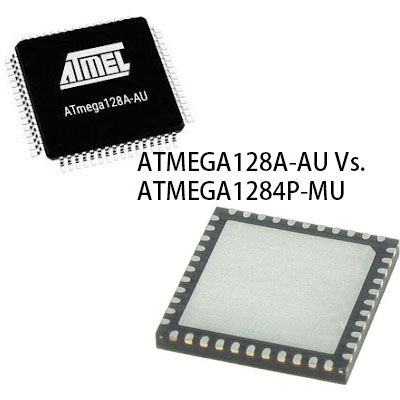
ATMEGA128A-AU vs ATMEGA1284P-MU: Differences and Similarity
yunying Release time:2023-12-08 Page View:219

ATMEGA128A-AU vs ATMEGA1284P-MU Overview
The ATmega128A-AU is an 8-bit microcontroller based on the AVR RISC architecture. It operates at a maximum clock frequency of 16 MHz and is housed in a TQFP package with 64 pins. It offers 128KB of flash program memory, 4KB of EEPROM, and 4KB of SRAM. The microcontroller features various communication interfaces such as USART, SPI, and I2C, along with multiple timers/counters and a 10-bit ADC. It operates at a voltage range of 1.8V to 5.5V, making it suitable for a wide range of applications.
The ATmega1284P-MU is also an 8-bit microcontroller based on the AVR RISC architecture. It operates at a maximum clock frequency of 20 MHz and comes in a QFN package with 44 pins. It offers 128KB of flash program memory, 4KB of EEPROM, and an increased SRAM capacity of 16KB compared to the ATmega128A-AU. Similar to the ATmega128A-AU, it supports USART, SPI, and I2C communication interfaces, multiple timers/counters, and a 10-bit ADC. It operates at a voltage range of 1.8V to 5.5V.
ATMEGA128A-AU vs ATMEGA1284P-MU Pinout
ATMEGA128A-AU Pinout
ATMEGA1284P-MU Pinout
ATMEGA128A-AU vs ATMEGA1284P-MU CAD-Model
ATMEGA128A-AU
Symbol
Footprint
3D-Model
ATMEGA1284P-MU
Symbol
Footprint
3D-Model
ATMEGA128A-AU vs ATMEGA1284P-MU Features
ATMEGA128A-AU vs ATMEGA1284P-MU Diagram
ATMEGA128A-AU vs ATMEGA1284P-MU Differences
The ATMEGA128A-AU and ATMEGA1284P-MU are two microcontrollers that share a common heritage but have some distinct differences. In this article, we will explore the similarities and differences between these two devices.
ATMEGA128A-AU and ATMEGA1284P-MU are both members of the AVR family of microcontrollers, designed and manufactured by Atmel Corporation. The AVR family is known for its small size, low power consumption, and excellent performance.
The ATMEGA128A-AU and ATMEGA1284P-MU share a similar feature set, including 80 general purpose input/output (GPIO) pins, a 16 MHz oscillator, and a rich set of peripherals such as timers, serial communication interfaces, and ADCs. Both devices are available in a variety of package options, including QFP, TQFP, and QFN packages, allowing for flexibility in board design.
Despite their similarities, there are some key differences between the ATMEGA128A-AU and ATMEGA1284P-MU. The most significant difference is the memory capacity. The ATMEGA128A-AU has 128 KB of flash memory, while the ATMEGA1284P-MU has only 4 KB of flash memory. This difference in memory capacity can affect the type of applications that can be developed on each device. The ATMEGA128A-AU may be better suited for more complex applications that require a larger code base, while the ATMEGA1284P-MU may be better suited for applications with more limited memory requirements.
Another difference between the two devices is the number of ADC channels. The ATMEGA128A-AU has 16 ADC channels, while the ATMEGA1284P-MU has only 8 ADC channels. This difference can affect the ability of each device to convert analog signals into digital data. The ATMEGA128A-AU may be better suited for applications that require precise analog to digital conversion on a larger number of channels.
The final difference to note is the type of power supply. The ATMEGA128A-AU requires a single power supply of 2.7 to 5.5 V, while the ATMEGA1284P-MU requires a dual power supply of 1.8 to 5.5 V for the core and 2.7 to 5.5 V for I/O. This difference in power supply requirements can affect the design and operation of the system power supply.
In conclusion, the ATMEGA128A-AU and ATMEGA1284P-MU are both excellent microcontrollers for a wide range of applications. Their common features and flexible peripherals make them easy to integrate into a wide variety of systems. However, their differences in memory capacity, ADC channels, and power supply requirements should be taken into account when selecting the appropriate device for a specific application.
Related articles:
Product comparison
-
ImagePart NumberManufacturerToleranceVoltage - RatedProduct StatusPackage / CaseProduct CategoryView Compare
-
-
-
Active
44-VFQFN Exposed Pad
Microcontrollers
-
-
-
Active
64-TQFP
Microcontrollers
-
-
-
Active
44-VFQFN Exposed Pad
Microcontrollers
-
-
-
Active
64-TQFP
Microcontrollers

Frequently Asked Questions
-
1,000+Daily Order Quantity
-
2,500,000+Alternative Parts
-
2,200+Worldwide Manufacturers
-
10,000 ㎡In-stock Warehouse






























